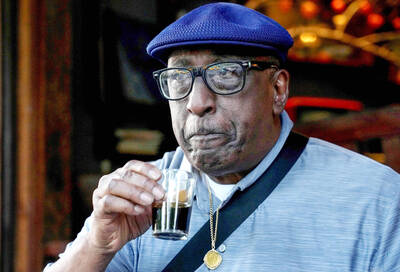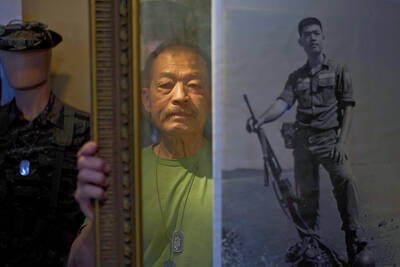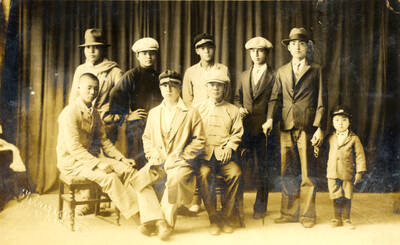Five years ago, after a hiatus of nearly three decades, I began swinging the driver again in Indonesia.
On one of my first times out, the Australian ambassador, Ric Smith, picked me up at 5 on a Saturday morning in Jakarta. "Buy 20 balls, and if you finish with five, you've had a good round," he remarked as we drove south, to give me some sense of the course we'd be playing, Jagorawi.
It wasn't much of an exaggeration. Hacked out of the jungle, the three Jagorawi courses (two 18s, and a nine) are hypnotically peaceful, staggeringly scenic — and maddeningly difficult.

PHOTO: NY TIMES NEWS SERVICE
Every time I start a round on Jagorawi's Old Course (built in the early 1970s), I find myself saying, "Ah, how beautiful can it be," as I look down at the fairway — yes, down, because it is some 30m lower than the tee, then gradually runs uphill more than 500 yards, and is lined on both sides with Norfolk pines and mahogany trees. Then I begin to worry whether my drive will clear the gulley and the flower bed to reach that fairway, and not stray into the trees.
There is no rough at Jagorawi. That may sound wonderful, but if you're not in the fairway, you're in the jungle, or river, or ravine, and village boys scramble after the balls, with an uncanny ability to find them — developed over the years and passed on to younger brothers — and then sell them back to you. Jagorawi golfers say you don't buy balls, you lease them, and more than one friend has sworn quite colorfully never to play this club again.
Think Indonesia and tourism, and the first thing that comes to mind is probably Bali. Think golf holiday, and most people would dream of Scotland or Ireland. But Indonesia harbors one of the best-kept secrets in the world of travel: It is a golfer's paradise.

PHOTO: NY TIMES NEWS SERVICE
Within an hour or so of Jakarta, there are more championship golf courses — designed by the likes of Arnold Palmer, Jack Nicklaus, Greg Norman and Robert Trent Jones Jr. — than probably in any other comparable geographic place on the planet; and the cost of a round is often less than the cost of a caddy at St. Andrews.
Jakarta also boasts of having one of the oldest golf courses in Asia, Rawamangun, also known as the Jakarta Golf Club. It was founded in 1872, and when Suharto ruled Indonesia, which he did with an iron hand for nearly 30 years, this is where he and his cronies played. It is an old-fashioned English-style course, short (you'll rarely use a driver) and tree-lined.
After playing five days of golf with me in Indonesia recently, an Australian friend, Tony Sernack, declared, "It's better than going to Sydney." That's quite a testimonial, given that Tony, a management consultant-cum-accomplished photographer, is a former chairman of greens at the New South Wales Club in Sydney, which has been ranked as one of the top 50 golf courses in the world; he twice played there with Bill Clinton. (He could dine out for a long time on the stories he has of those rounds.)
I took Tony first to the New Course at Jagorawi. I bogeyed No. 11, a par 5. On No. 12, I thought, well this should be an easy par — only 153 yards. But you have to hit the green, and hold it — too short, and you're in the ravine or the steep bunkers in front; too long and you're in another bunker, or the river behind.
Then came No. 13. Every time, I vow not to think about the ravine just ahead, which requires a drive of over 150 yards to clear. And the fairway quickly narrows, with jungle on the left and right. I usually don't succeed in hitting the fairway, and thus make another donation to the village boys (they got two from me that day).
On No. 14, you look at another ravine from the tee, and another one after that — and more boys scrambling into place for an errant shot.
They call it an "amen corner" for good reason.
But if you don't want to pray (or curse), just head down the road, for less than 15 minutes away are two superb clubs, Riverside and Emeralda. Riverside is longer and tougher, with a double dogleg par 5.
Adjacent to Riverside is Emeralda, which has three nine-hole courses – the River and Lake layouts were designed by Palmer; a third nine, Plantation, by Nicklaus. The courses are well maintained and manicured, with undulating greens. There is rough, and it's nasty.
But there is also whimsy. No. 4 on Plantation is an interesting 154-yard par 3, over a paddy field with stick-figure scarecrows in local dress.
The three Emeralda courses were completed in 1995. There was to have been a fourth, but the Asian economic crisis crashed the business dreams.
Just what that meltdown did to the ambitions of golf developers is even more visible at Rainbow Hill (or Bukit Pelangi in Indonesian). It is situated in the mountains near Bogor, a pleasant city with a noted botanical garden and the royal palace where President Bush met in November with the Indonesian president, Susilo Bambang Yudhoyono.
You gasp upon entering the clubhouse and viewing the course through two-story high windows. Playing this hilly course, you get a look at recent Indonesian history — environmental, economic and political. Beyond the trees and other colorful flora on the course, the terraced hillsides are scarred and denuded — an all-too-familiar sight in Indonesia, and which partly explains why rains in February triggered horrific floods.
Along the fairways stand gray, silent shells of huge mansions — it looks like Sarajevo during the war. This was intended to be a major resort development, and one stares in jaw-dropping disbelief at what was planned, and is now abandoned. A Sheraton Hotel is partly built; the stadium tennis courts, dreaming of international tournaments, barely started.
That economic collapse also explains why it is easy and inexpensive to play there — quality courses desperate for greens-fee-paying players are charging as little as 245,000 rupiahs, about US$26 at 9,270 rupiahs to the US dollar. But as the Indonesian economy picks up, which it is, I imagine that it won't be long before it will be much harder, and certainly more expensive.
I'm not the only foreigner who took up golf while living in Jakarta. Many ambassadors and expatriate executives who had never played before become true believers, routinely getting up at 4:30am or 5am on a Saturday morning (not easy in a city with a vibrant night life).
For one thing, with the pollution and traffic, and little green space, golf offers a rare chance to get some outside activity. And the cost of playing is a fraction of what it would be in the US, Europe or Australia — only on Bali does it cost more than US$100 a round, and on most courses the greens fee during the week comes to less than US$50.
(The only months when the weather is a problem is the December-to-February rainy season. Extremely rare, however, is the day that it is impossible to play at all. The hard rains, often accompanied by lightning, which causes courses to sound the siren, are usually in the mid-to-late afternoon.)
Finally, professional lessons are available, from Australian, British, South Korean, Indonesian pros, for as little as US$25 an hour. There is no guide to instructors, but they can be found at any of the driving ranges, or through local golfers, whom you will easily meet.
Recently, a sophisticated golf school, the Bank Commonwealth Institute of Golf, opened at Jagorawi, where two young Australian pros give 45-minute private lessons for US$50 (www.bciog.com). One instructor, Daniel O'Neill, even convinced me that I could use one of those monster-headed drivers. I had limited my tee shots to a 3-wood, having read somewhere that if you're over a 15-handicap, leave the driver at home. Under Daniel's tutelage, I began hitting the driver not only farther, of course, but also straighter, which stunned me.
The school is trying to develop junior golfers, to represent Indonesia on the international circuit. Keep your eyes out for Ujang Zarems, who started chasing balls like other village boys, but is now a willowy 1.5m, 50kg 15-year old — with a 3 handicap!
Many of Ujang's friends from the village are caddies. The caddies may be legendary at St. Andrews, but caddies are surely Indonesia's golf signature. The charges vary from course to course, but US$10 is tops, and most golfers, except the stingy, tip US$10.
Some caddies have single-digit handicaps, and it becomes like playing with an instructor: "You lifted your head." "You didn't follow through."
They can read greens to within a blade of grass. "Two balls left." "Uphill." "Fast green."
After playing numerous rounds with these caddies, I was lost when I went to the US or Australia and played. Do I hit a 5-iron or a 6-iron? How far right should I putt this for the break? When I returned to Indonesia, I still took a caddy (most courses require you to), but I listened to him, or her, less, and tried to make my own decisions.
Yes, there are female caddies. On most courses, the caddies, who pull or drive carts, are young women.
Indeed, that is part of the experience, in the eyes of most expatriates who play there. When Tony and I asked local golfers where to play on his last day, after we had already had rounds at Jagorawi, Emeralda and Rainbow Hill, one of the courses recommended was Bogor Raya. It has "the most beautiful caddies in Asia," more than one told us.
It is also a challenging course, but we opted for Bumi Serpong Damai, where the female caddies wear long-sleeved shirts (protection against the sun) with pink hoods. We played behind a lithe Singaporean woman in her 30s, with a long pony tail, three kids and a rhythmic swing.
I left this course, designed by Jack Nicklaus, with one memory: sand. Along the left side of the sixth hole, a short par 4, the bunker runs more than 91m. I avoided that, by going too far right, into some low, thick shrubs.
Then I faced the green, where they had placed the pin in the left corner. If I hit over the green, I'd be in more jungle, or the river. I hit to the right and then faced an unpleasantly long put on an undulating green. In general, the greens are nasty.
Golf in Indonesia has something else to offer: ways to make you forget the last four hours and take away the aches. Nearly every course has a spa — hot tub, cold tub, sauna and massage. With little question, however, the best massages are not at any golf course, but at Bersih Sehat, which offers a "massage for the family."
A massage in Indonesia that isn't a euphemism for other activity is a rarity, and Bersih Sehat, which has several locations in central Jakarta, is that exception. For US$10, you get an hour-long massage that is unmatchable, and leaves you ready for another round tomorrow.
DIY VACATION
There are no accomplished golf tour operators in Indonesia, so a golf holiday there is a do-it-yourself operation. But don't let that deter you. Golf Promo Indonesia, at www.indogolf.com, gives basic information on dozens of courses on Java, Bali and other islands.
Don't be put off when you read that a course is for "members and guests." During the week, it is possible to play almost any course. Greens fees fluctuate roughly from US$30 to more than US$100, depending on time of year, day of the week and the exchange rate, which is now about 9,270 rupiahs to the US dollar.
GETTING AROUND
There are two options — and renting a car and driving yourself is not one of them. Either hire a hotel car and driver, or a Silver Bird taxi (+62-21-798-1234 or +62-21-794-1234). Its cars are comfortable, spacious sedans, and the drivers are reliable and honest. From most major Jakarta hotels to Jagorawi, Riverside, Emeralda and Bogor, it will be less than US$50 round trip. A hotel car and driver will cost at least twice that.

On April 26, The Lancet published a letter from two doctors at Taichung-based China Medical University Hospital (CMUH) warning that “Taiwan’s Health Care System is on the Brink of Collapse.” The authors said that “Years of policy inaction and mismanagement of resources have led to the National Health Insurance system operating under unsustainable conditions.” The pushback was immediate. Errors in the paper were quickly identified and publicized, to discredit the authors (the hospital apologized). CNA reported that CMUH said the letter described Taiwan in 2021 as having 62 nurses per 10,000 people, when the correct number was 78 nurses per 10,000

As we live longer, our risk of cognitive impairment is increasing. How can we delay the onset of symptoms? Do we have to give up every indulgence or can small changes make a difference? We asked neurologists for tips on how to keep our brains healthy for life. TAKE CARE OF YOUR HEALTH “All of the sensible things that apply to bodily health apply to brain health,” says Suzanne O’Sullivan, a consultant in neurology at the National Hospital for Neurology and Neurosurgery in London, and the author of The Age of Diagnosis. “When you’re 20, you can get away with absolute

When the South Vietnamese capital of Saigon fell to the North Vietnamese forces 50 years ago this week, it prompted a mass exodus of some 2 million people — hundreds of thousands fleeing perilously on small boats across open water to escape the communist regime. Many ultimately settled in Southern California’s Orange County in an area now known as “Little Saigon,” not far from Marine Corps Base Camp Pendleton, where the first refugees were airlifted upon reaching the US. The diaspora now also has significant populations in Virginia, Texas and Washington state, as well as in countries including France and Australia.

May 5 to May 11 What started out as friction between Taiwanese students at Taichung First High School and a Japanese head cook escalated dramatically over the first two weeks of May 1927. It began on April 30 when the cook’s wife knew that lotus starch used in that night’s dinner had rat feces in it, but failed to inform staff until the meal was already prepared. The students believed that her silence was intentional, and filed a complaint. The school’s Japanese administrators sided with the cook’s family, dismissing the students as troublemakers and clamping down on their freedoms — with